There are two important types of charts in every Aussie’s life: the Aussie Shepherd growth chart, and the Australian Shepherd feeding chart.
Both will tell us if our Aussie puppy is growing up nicely and eating the right amount of food.
Back then, Aussies were used for herding purposes. But, today, that task is almost completely replaced by being a human’s companion. Still, their genetics haven’t changed, and Aussies need their high dose of protein to satisfy their cravings.
But, what kind of dog food do Aussies really need? How much should they eat? Are there any developmental milestones we should know about? How do you feed dogs during that process?
Stay tuned to find out more!
Australian Shepherd Puppy Feeding Chart
| Age | Food amount |
|---|---|
| birth | mommy’s milk |
| 3.5 weeks | milk formula |
| 4 weeks | ½ to ¾ cup puppy kibble, one meal |
| 6 weeks | 1 cup, 3 meals |
| 8 weeks | 1.5 cup, 3 meals |
| 10 weeks | 1.5 cup, 3 meals |
| 12 weeks | 1.5 to 2 cups, min. 3 meals |
Aussie Shepherd Puppy Food Chart By Months
| Months | Amount |
|---|---|
| 4-5 | 1 ¾ to 3 ⅓ cups |
| 6-8 | 1⅓ to 3 ¼ cups |
| 9-11 | 2⅓ to 4 cups |
| 12-24 | 2⅓ to 5 ¼ |
What Is The Weight Of An Australian Shepherd?
The Australian Shepherd is a purebred dog. As such, they have a breed standard that reliable breeders have to keep in mind when breeding new puppies. Some deviation from the recommended size and weight is okay as long as it’s only a few pounds.
Significant differences, such as ten pounds or more over or under the lines should not be tolerated.
Your average Australian Shepherd is a medium-sized dog breed. Their body frame is sturdy, with a low center of gravity. As such, Aussie Shepherds weigh 50 to 65 lbs. Those are male examples of the breed.
Female Aussies are slightly lighter, and weigh from 40 to 55 pounds.
What’s interesting about this dog breed is that they seem to be longer than they are taller. They’re lean, fit, and very agile. But, overweight Aussies are definitely not, so keep an eye on the scale.
What Are The Amounts Of Food An Australian Shepherd Should Eat Per Day?
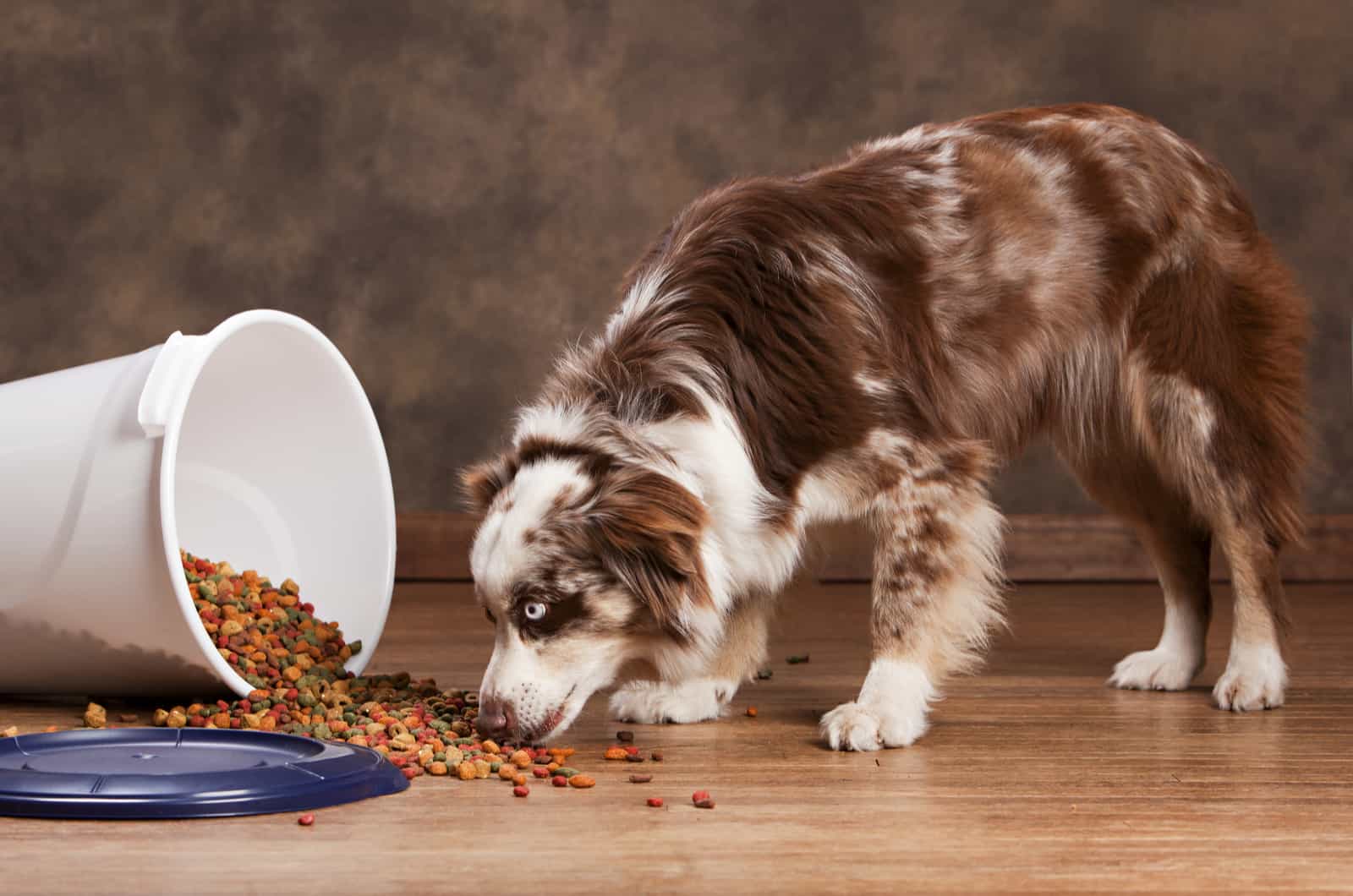
Let’s say we’re talking about an adult Australian Shepherd. Puppies have different routines and different nutritional needs.
Adult Australian Shepherds will drop down from having three to four meals a day, to only two or even one meal a day. The number of meals is individual.
When an Aussie turns 12 months old, adult pet food should already be in use for a while. This is the time when puppies usually either stop growing, or grow only a little bit more throughout the next 12 months.
Your Aussie won’t need too much food at this life stage. Adult dogs need food for energy, not for growing up.
Monitor your dog and make sure you understand its needs. Some pups find one meal not to be according to their nutritional requirements. Two meals would be just fine!
We can’t come up with a strict rule of how much Aussie Shepherds must eat daily. They can devour up to five cups, divided carefully into two meals. If you notice food being left behind your pup, pick it up and reduce the amount of kibble gradually until you figure out the ideal meal.
What Is The Recommended Feeding Schedule For An Australian Shepherd?
As mid-sized dogs, Australian Shepherds will never be chubby buddies. They’re fit doggos, even as puppies. So, don’t expect to see a little Michelin, baby-like puppy with this dog breed.
All puppies grow differently. There’s even a significant difference between puppies of the same breed.
We can’t put a finger on a number and say it’s the ideal weight for Aussie puppies at the age of five months.
However, we can find a range that will help us determine whether our Aussie puppy is growing up nicely and putting on weight just the way he’s supposed to. And, that range is from 40 to 65 pounds, as I mentioned earlier.
Scheduling Your Dog’s Meals
Now, we come to a matter of frequency of the meals. In order to reach the recommended weight, Aussie Shepherds should consume enough nutrients and eat plenty of food that will give them energy.
Still, this doesn’t mean that you should free-feed your dog or give him five meals a day. When they become adults, the number of meals drastically drops down. Quality becomes more important than quantity.
If you believe that dogs can’t tell if they have a schedule or a routine, you’re wrong. With time, dogs learn that they have a set routine during the day. Usually, their day starts with going potty, then having breakfast.
At the end of the day, dinner or their second meal is anticipated. Dogs, especially breeds that are known for their intelligence, will gladly remind their owner that its kibble time!
By assigning a proper feeding schedule, you’re teaching your dog obedience. Also, it’s proven to be quite efficient with dog breeds that drool a lot. Simply, if you keep the food bowl empty and fill it up at a specific time, you’ll reduce the amount of dog drool when your excited dog sees the kibble.
Aussie Shepherds aren’t big droolers, but they can become nervous or hyperactive if you don’t follow their feeding schedule.
Stick to the mentioned feeding schedule to keep your dog’s weight under control.
Transition From Puppy Food To Adult Food
After being weaned from their mommy’s milk, Aussie Shepherd puppies will need only high-quality food designed for puppies.
Growing puppies will need plenty of nutrients to support their growth, boost their immune system, and give them plenty of energy to satisfy their high activity levels. Puppies are much more energetic than older dogs. They don’t need carbohydrates to keep them going.
Puppies need healthy fats like omega 3.
Find the best dog food on the market by looking at the back of the package. Pick only recipes with real meat protein, grain-free, soy-free, and preservative-free dry kibble.
When the transition begins, somewhere between the 6th and the 12th month of age, you slowly replace one part of your puppy’s food with the new adult dog food. You’ll know what’s the right amount of replaced kibble if your puppy eats the meal without fussing about it.
Increase the amount of dry dog food gradually before you replace the whole bowl of puppy food with adult dog food.
It’s as simple as that!
The transition should happen slowly, and with constant observation. If you notice that your puppy needs to slow down or change the brand, do it, and start the transition process over. If you do this “cold turkey”, you will definitely trigger issues with your dog’s diet and digestive system.
Should Your Australian Shepherd Take Supplements?
Do you mean food supplements like some vitamins and minerals? Something like calcium or vitamin B?
Well, I’m here to tell you that dogs don’t need them. In fact, dogs don’t need any supplement that we’re familiar with. And, there’s a pretty simple reason why that is so.
Now, I know you all want only the best for your pups. But, you need to find the difference between our diet and our dogs’ diet. Sometimes, we need supplements to become healthier.
Dogs do not need supplements… period.
They get plenty of nutrients from their chosen dog food. Even if your dog is on a homemade raw diet, you can still make recipes rich in vitamins, minerals, and all the other goodies.
Supplements are only okay if your dog has a special condition or if your veterinarian has prescribed them. Don’t take them deliberately and hand them out like snacks.
Water Intake For Aussie Shepherds
If you thought you’d find some water recommendations for your Aussie Shepherd, I hate to disappoint you. Not only are there no recommendations for the Australian Shepherd dog breed, but there are no water recommendations for any other dog breed.
Simply put – let your dog drink as much fresh water as he wants!
Water is what makes our body move and function normally. Our cells need water, even when we’re resting. Just imagine how much water that a dog that is tired from running with his owner needs!
Always make sure there’s fresh water within your dog’s reach. Don’t ration it, ever.
If you’re going for a jog, bring a water bottle for your dog, too. I used to do this all the time when I was a runner with my dogs. Circumstances have changed, but I still carry an additional water bottle in case my pup gets thirty on our daily walk.
There’s no such thing as too much water, especially not for dogs. They’re designed differently than we humans, and they need to stay hydrated. Remember, dogs don’t sweat through their skin; they sweat through their paw pads and nose.
What Do You Do If Your Australian Shepherd Refuses To Eat?

Refusing to eat isn’t uncommon with dogs of any breed. There are always some major reasons behind such behavior. Usually, it’s a medical problem that prevents your dog from eating a lot or eating at all.
Of course, there are some pretty harmless causes behind rejecting food.
First, let’s clear up some of the most benign reasons.
Usually, dogs reject food if they don’t like the texture or the taste. If your Aussie Shepherd is on kibble, maybe trying some new brands, or buying wet food won’t be such a bad idea. Also, try adding warm water to their kibble to soften it up a bit. Puppies prefer eating kibble this way.
Dogs that refuse food for the reason explained above are behaving normally. They’re not depressed or lethargic. However, if your dog has these symptoms, and refuses to eat and drink for a significant period of time, then it’s time to see the vet.
Dogs can also refuse to eat because they have some minor (or even major) health issues.
Puppies that are teething often skip meals because it’s too painful for them to chew. In this case, wet food is the best option.
Any other health issue that might steer your Aussie pup away from eating requires medical help.
Also, I want to add that sometimes, it’s just not the right time. Maybe your dog is too tired to eat? Maybe he wants to take a nap, or he feels thirstier than hungrier? Don’t push it unless you notice serious symptoms.
What Do You Do If Your Aussie Shepherd Has A Large Appetite?
Dogs, and our Aussie Shepherd, too, can either boycott meals or eat too much. They can be quite gluttonous in certain situations. Whether they haven’t had enough food, or they simply like their meal, dogs shouldn’t eat more than what’s recommended for them.
Every dog owner should come up with a feeding plan or follow one created by the dog’s vet in order to make sure two things are considered: the recommended daily nutrients, and the recommended daily amount of food.
I know it will be tempting from time to time, but try not to sneak in extra meals or extra snacks for your dog. One day won’t make a difference, but it will easily become a nasty habit. And, trust me – that habit can only lead to obesity.
One of the biggest reasons why your dog may feel like he needs more food in one meal is due to the speed by which he eats that meal. If your dog inhales kibble like crazy, he will eat it too fast, which will send signals to the brain that he hasn’t had enough food.
That’s a completely wrong reality for your pooch, and it can become really nasty behavior.
Slow down your dog during meal time by putting the food into a slow-feeder type of bowl. You can even scatter around the kibble so your dog can chase it. I’ve seen some pretty hilarious videos of dogs eating food all over the floor just because they’re fast eaters.
If your dog is really THAT hungry, you can give him a little treat, but make sure he fights to get it. Use puzzle dog toys, so he works his little bum off to figure out a way to get it.
Lastly, make sure your dog food isn’t poor in nutrients, which may cause constant hunger with your pupster.
Can Australian Shepherds Eat Raw Dog Food?
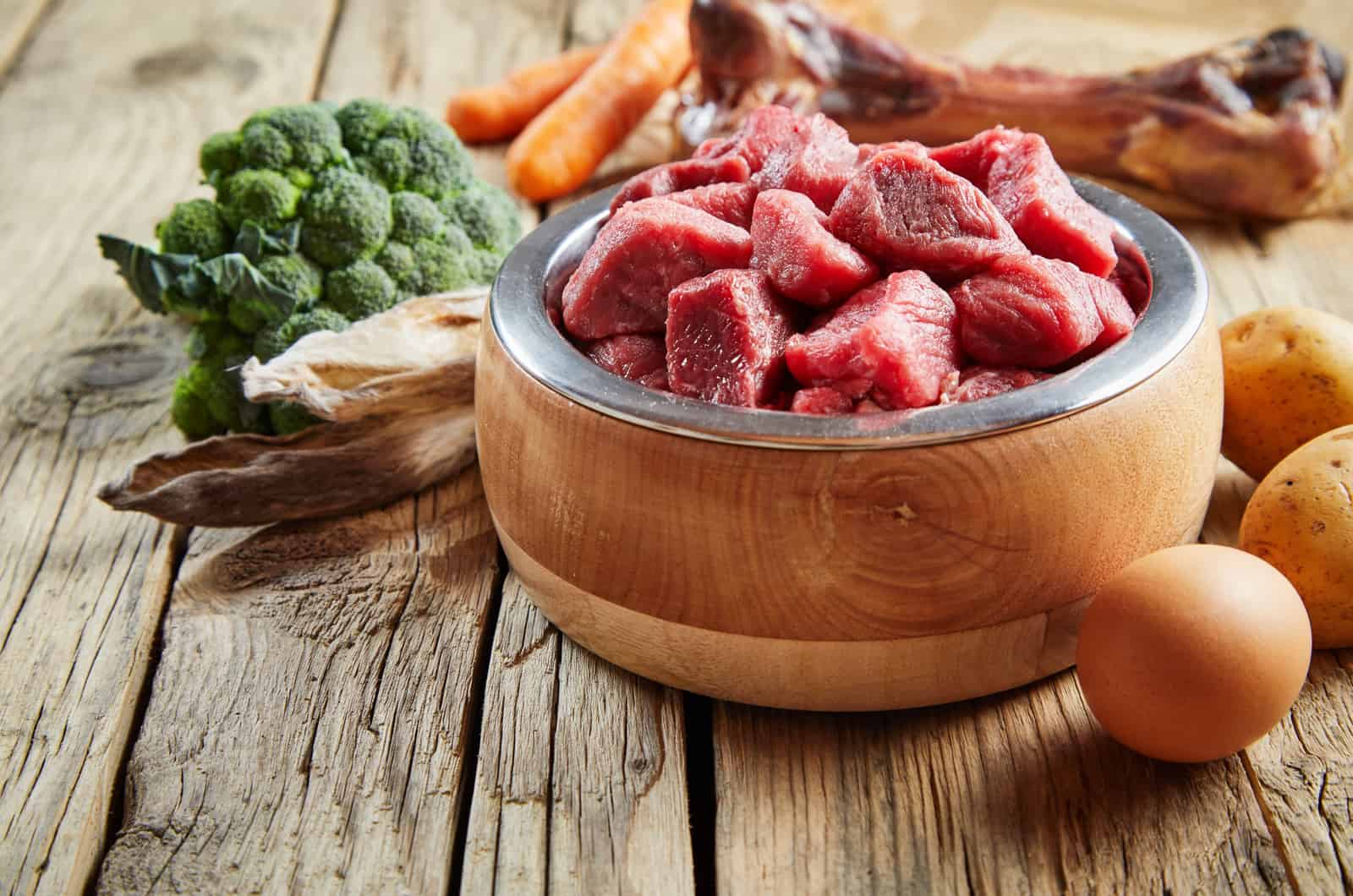
What do you know about BARF?
Seriously, I’m not asking you about barfing, but instead, about a special raw diet that dogs consume.
The first time I heard about dogs eating raw dog food was way back in the past. I heard that dogs, like the Cane Corso, enjoy raw meals. It’s described as a way of them getting in touch with their primal side.
When you think about it in depth, there’s a valid point behind feeding a dog raw food. After all, dogs were domesticated. Back in the days, do you really think they used to have kibble, or did they eat raw meat and bones?
Exactly!
My point is, there’s nothing bad in raw food. But, you need to learn how to dose it, and which ingredients bring the best amount of nutrients. Raw dog food doesn’t only consist of meat, bone marrow, or bone. Fruits, veggies, and grains can also be incorporated.
Benefits And Disadvantages Of Raw Dog Food
Benefits
The reason why dog owners opt for raw dog food is that it brings many benefits. Once you hear why it is good for your Australian Shepherd, you will definitely consider following the BARF movement.
First off, raw food helps a lot with a dog’s immune system. Nutrients in their raw form truly bring on their A game. Just think about it: is it better to eat something fresh rather than to have it processed? Isn’t a fresh apple better than store-bought apple puree?
Since they’re rich in fibers, raw meals will benefit a dog’s digestion. We all know how painful doing number 2 can be.
Also, home-prepared raw dog meals will make your dog’s coat shinier, and its teeth cleaner.
But, definitely, the biggest benefit or advantage of raw doggy meals is that you always know what you’re giving your dog to eat. No hidden fillers, no poor nutrients! Only the best for your buddy from Down Under!
Disadvantages
Australian Shepherds are very energetic dogs. They’re constantly jumping around you and being active like they’re battery-powered puppies!
So, imagine preparing a raw meal with your impatient Aussie next to you. Raw meals take time, and they aren’t a good choice when you’re in a hurry. You’ll have to find a good storage space and prep your raw doggy meals according to health regulations.
Otherwise, your pup would be risking salmonella and other food-borne infections.
Since some raw meals include shattered bones and bone fragments, it can be tricky for your dog to digest them. Worst case scenarios include intestinal bleeding from ruptures caused by broken chicken bones, or even choking!
Besides being time-consuming, a raw diet is somewhat expensive.
So, keep both advantages and disadvantages in mind when you’re choosing the best diet for your Australian Shepherd.
What Kind Of Nutrients Does My Aussie Need?
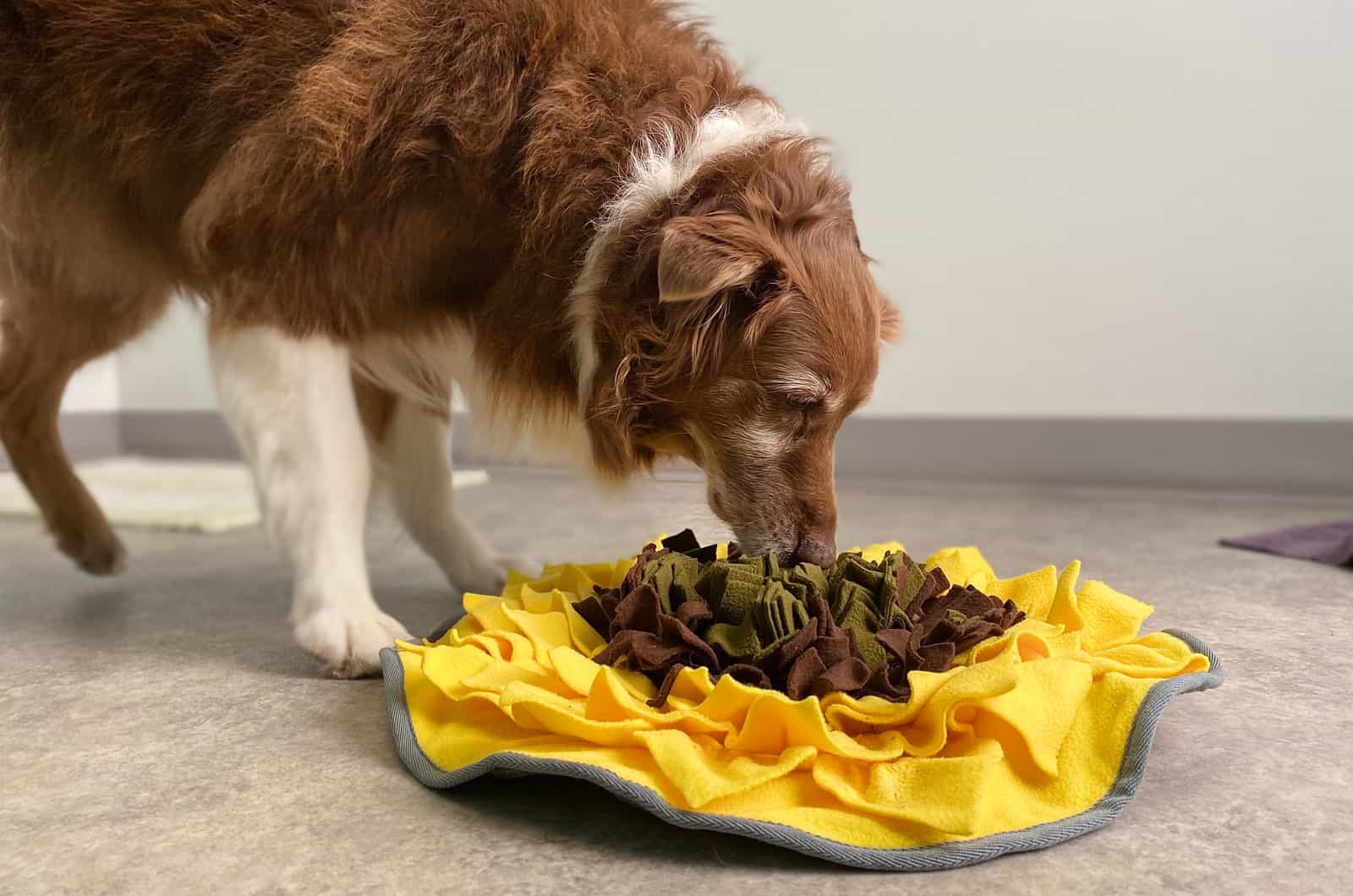
All dogs, not only Aussie Shepherds, need food based on protein. The higher the protein count is, the better. The second most important nutrient for these dogs is fat.
Fats aren’t necessarily bad for your dog. There are fats that make our dog’s health status much better, such as omega fatty acids.
Vitamins and minerals can be found in fresh fruits and veggies. If you take a look at the back of the dog food bag, you’ll see that it probably contains fruits like blueberries or apples. Sometimes, sweet potato is featured as one of the top five ingredients.
Fruits and veggies are superfoods packed with all the goodies your dog will need for a balanced diet.
What I don’t like seeing on dog food bags are grains, gluten, and soy. They’re only fillers stuffed with carbs that bring nothing good to your dog. And, on top of everything, they can trigger severe food-related allergies with your dog.
But, of all the available dog food brands on the market, which one should you choose? Which one contains only the best ingredients? You’ll find that in the following section!
Which Dog Food Brands Should I Buy For My Aussie?
Personally, I have never bought dog food (no matter if it’s canned or dry dog kibble) at a supermarket. Call me crazy, but I haven’t.
Ever since I got my first puppy as a kid, my dad told me that dogs can’t eat garbage. They can’t eat human food like spicy food, or even junk food like Cheez-Its. They need high-quality recipes with nice ingredients.
But, for real – how else can a puppy grow unless he only eats great nutrients?
That’s why when I got my first pup as an adult, I immediately skipped local supermarkets and ordered from Amazon. I believe it was some recipe from Blue Buffalo.
What I did was I went online and Googled which dog food ingredients are recommended and which are not. Using a system of elimination, I found the top three brands that make extra-delicious, and extra-safe kibble for our Aussie Shepherds.
To make this story a bit shorter, here are my top three dog food brands.
Blue Buffalo
As I already told you, Blue Buffalo was my first brand of kibble. I seriously can’t remember which kibble I used, but I knew it was good… well, good until my puppy developed a condition and needed to be put on a special diet for the rest of his life.
Samson passed away after only a couple of short years with me, but the name, Blue Buffalo, kinda stuck in my head.
Blue Buffalo is a pricey choice, but they seriously have no flaws. Their Life Protection formula has everything a dog could wish for. It’s low in poor calories, high in nutrition, and super gentle on a dog’s digestion.
Taste Of The Wild
Fresh beef contains lots of protein, and that’s exactly what your dog needs.
Normally, I prefer poultry- or lamb-based dog food (or maybe my dogs prefer it). But, I had to give my recommendations to the Taste Of The Wild recipe. Even though they have other dog kibble flavors, their TOTW beef is highly popular.
All dogs seem to enjoy this dog food brand. The reason why I like it so much is the grain-free formula with lots of natural ingredients. TOTW is one of those dog food brands you don’t see on commercials every day, but you simply know they’re a good choice for your canine,
Orijen
Orijen, especially their Regional Red formula, is packed with protein from real meals. They have more than one protein source, including beef, goat, wild boar, lamb, and lamb liver.
The Orijen recipe is biologically-designed for dogs like Australian Shepherds. I see absolutely no disadvantages of this kibble, but one. It’s the price!
Still, I wouldn’t care too much for the price if you want only top dog food brands for your Aussie. And, trust me – Orijen, along with Blue Buffalo and TOTW, is the holy trinity of dog kibble.
How Do I Tell If My Aussie Puppy Has A Healthy Weight?
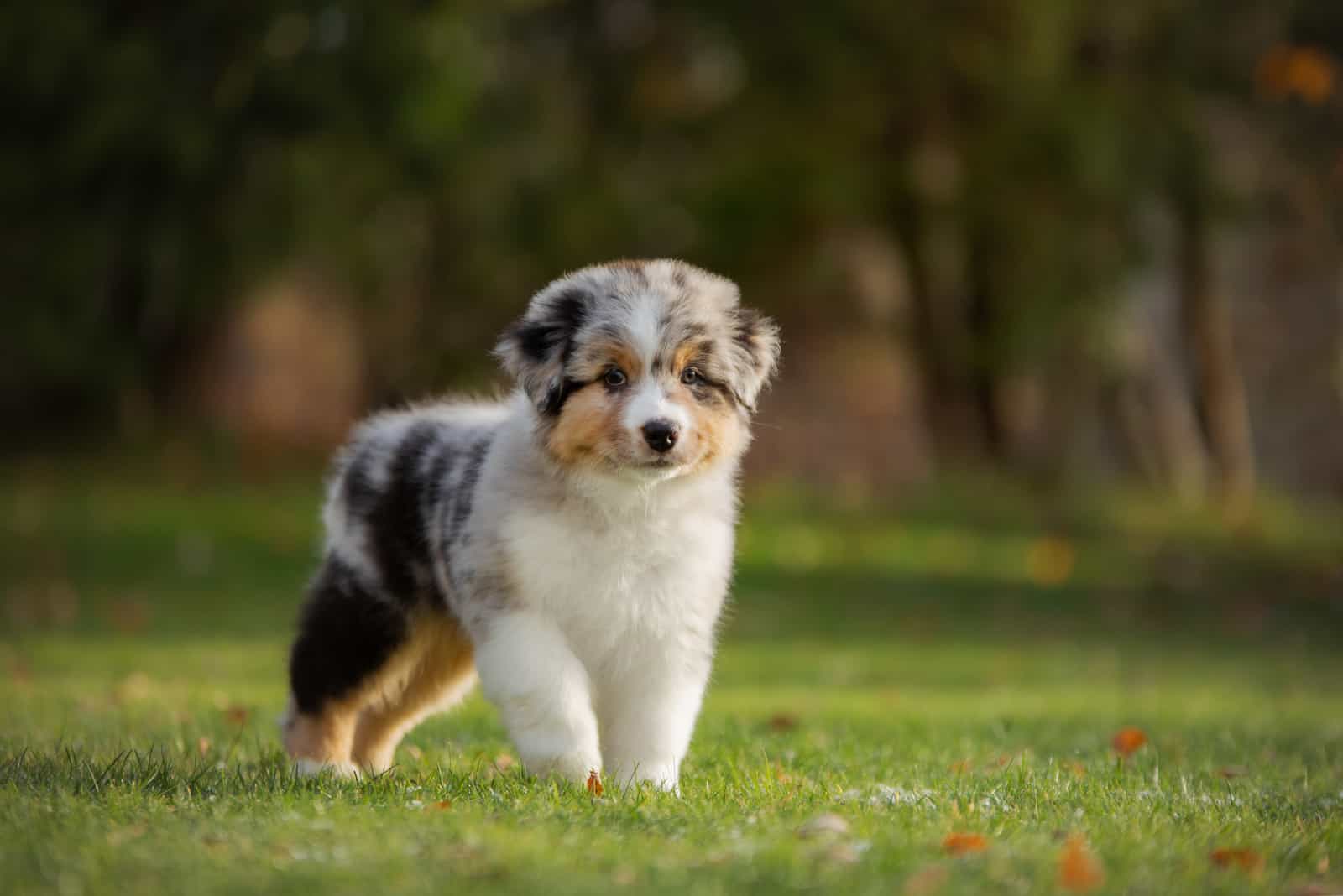
Probably one of the biggest doubts in every dog owner’s life is whether his puppy is growing up nicely. Finding that perfect weight range for growing puppies isn’t easy. I like to say that everything’s okey-dokey if the puppy is putting on weight instead of losing it.
Let’s face it: not every puppy is the same. Some puppies will put on weight faster than others. Slow weight gain is also okay if it follows the recommended weight guidelines for the Australian Shepherd dog breed.
So, how do you tell if your pup weighs according to plan?
Besides the obvious method of weighing your dog, you should be able to perform a visual evaluation. A simple eye test will easily tell you if your pup is underweight or overweight.
When you look at the side of your dog, you should notice there’s a little tuck on its stomach. It’s called the abdominal tuck, and having just a little tuck is perfectly fine.
Also, protruding ribs, or ribs you can feel easily is a sign that your dog needs more nutrition. If you can’t feel the dog’s ribs, it’s time for a doggy diet!
Being underweight isn’t good for any dog breed. Being overweight isn’t good either!
Australian Shepherds are very prone to hip dysplasia – a severe mobility health issue. Obese dogs with hip dysplasia will have even more problems! And, where are cardiac issues, cancer, diabetes?
Remember, Aussies are not large-breed dogs. Their bones were built to support medium-sized weight. Too much pressure on them for a long period of time will cause irreparable damage.
What Kind Of Dog Treats Should I Feed My Australian Shepherd?
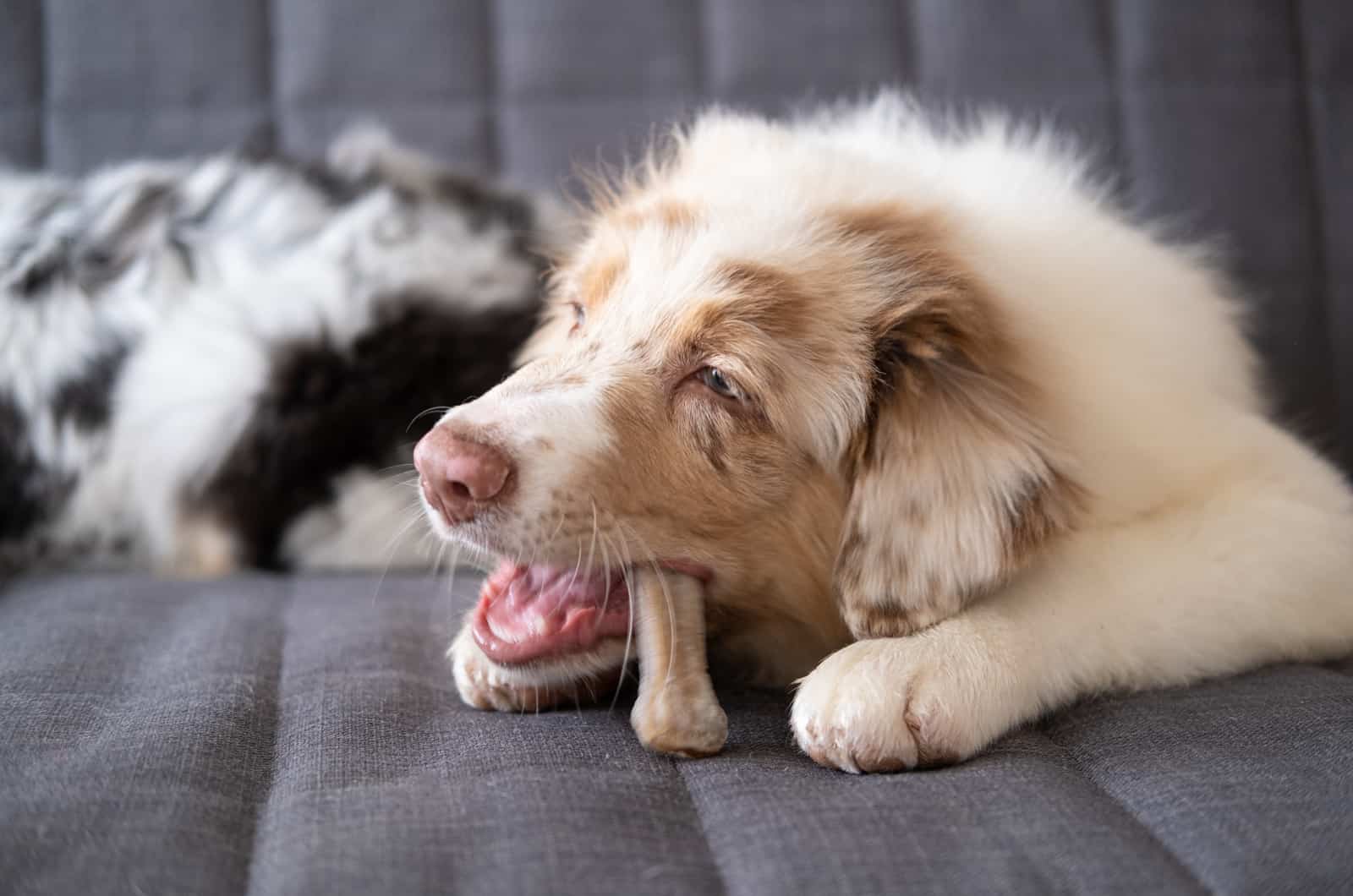
We come to the part that most dog owners don’t really find threatening. But, the truth is very different from what we all believe.
One treat won’t hurt your dog. Two won’t either. But, three, four, and more on a daily basis will turn into a bad habit. Your dog will begin to expect treats all the time. If you didn’t realize this earlier, treats are bigger culprits for obesity than regular meals.
Back in my volunteering days, we rescued a pup from an old man. The dog was kept on a chain all the time, but the owner justified it with the following. He used to give him endless amounts of kibble and two to three packs of some generic-brand doggy snack a day!
The poor pup was severely obese and, shortly upon rescuing, had heart failure. What caused it? Obesity.
Now, I know the owner only wanted the best for him (despite the chain thing). But, by believing that he was doing his best, he actually did his worst.
Learn from this lesson – Doggy snacks and treats are only okay occasionally, and only in a small amount.
Since Aussie Shepherds are food-motivated, it would be better to use fruits or veggies that are safe for dogs, such as new doggy snacks. Training is a lot easier if you hand out treats. Make your dog like snacks such as broccoli, brussels sprouts, papaya, apples, blueberries, sweet potatoes, etc.
Healthy fruits and veggies won’t add extra pounds to your dog’s weight, and they will definitely help you feed your dog healthier.
If you really must buy snacks that are already prepared, choose brands that aren’t highly popular like Purina. Small brands usually care more about their ingredients. See the back of the package, and only pick recipes with the most natural ingredients possible.
Conclusion
Every Aussie dog owner should have an Australian Shepherd feeding chart printed on the door of their fridge. Getting used to the fact that you’re responsible for a living being is already hard. Imagine how difficult it is to figure out all the tricks concerning feeding a growing Aussie puppy!
But, I wouldn’t worry if I were you. Feeding charts are pretty helpful. Your chosen breeder can provide you info, too! Also, you have this helpful article on the Australian Shepherd feeding chart!
I’d say you’re all set to adopt an adorable Aussie and make your life much better!
Dogs will be dogs. They won’t eat, but then they will start behaving like starving menaces. They will jump up and down, but then they’ll doze off to dreamland. Everything is possible with them, even significant contrasts.
The important thing is not to follow weight charts blindly. Let your dog live and breathe. Feed your pup the amount of food he can actually eat. Don’t overfeed or underfeed!
Simply put – just follow the basic guidelines that you can find here on feeding Aussie Shepherds, and you’ll be good.













